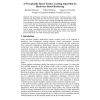Free Online Productivity Tools
i2Speak
i2Symbol
i2OCR
iTex2Img
iWeb2Print
iWeb2Shot
i2Type
iPdf2Split
iPdf2Merge
i2Bopomofo
i2Arabic
i2Style
i2Image
i2PDF
iLatex2Rtf
Sci2ools
RT
2001
Springer
2001
Springer
A Perceptually-Based Texture Caching Algorithm for Hardware-Based Rendering
: The performance of hardware-based interactive rendering systems is often constrained by polygon fill rates and texture map capacity, rather than polygon count alone. We present a new software texture caching algorithm that optimizes the use of texture memory in current graphics hardware by dynamically allocating more memory to the textures that have the greatest visual importance in the scene. The algorithm employs a resource allocation scheme that decides which resolution to use for each texture in board memory. The allocation scheme estimates the visual importance of textures using a perceptually-based metric that takes into account view point and vertex illumination as well as texture contrast and frequency content. This approach provides high frame rates while maximizing image quality.
| Added | 30 Jul 2010 |
| Updated | 30 Jul 2010 |
| Type | Conference |
| Year | 2001 |
| Where | RT |
| Authors | Reynald Dumont, Fabio Pellacini, James A. Ferwerda |
Comments (0)

